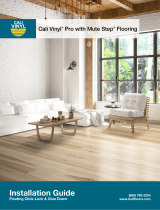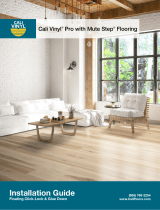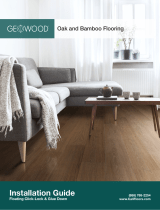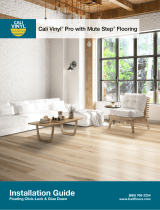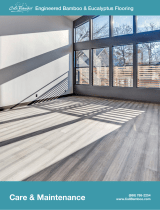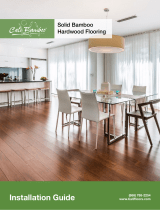Page is loading ...

Care and Maintenance Guide
(888) 788-2254
CaliFloors.com
Care and Maintenance
(888) 788-2254
CaliFloors.com
cork

Care and Maintenance
Care and Maintenance Guide
(888) 788-2254
CaliFloors.com
General Care
• For general cleaning, dry or damp mop as needed using Bona Stone Tile & Laminate Floor
Cleaner or something similar
• Never use a steam mop or wet-mop as standing water may cause permanent damage and
the heat from the steam mop may dull the finish. The moisture from the dampened mop
should evaporate off the floor quickly.
• Although Cali Cork is water resistant, it is still a best practice to avoid excess moisture on the
floor. Therefore, we recommend soaking up spills immediately using a dry towel or dry mop.
• Cali Cork floors, like all cork flooring, are subject to changes in temperature and humidity.
As a general rule, flooring will perform best when the interior environment is controlled to
stay within a relative humidity range of 35%-65% and a temperature range of 60° to 80°
Fahrenheit. Seasonal fluctuations in relative humidity may cause the cork flooring to gain
moisture with periods of high humidity and lose moisture during low periods of humidity.
During warm, humid weather, cork expands and during dry weather, cork contracts. These
changes may be noticeable but can be minimized by using an HVAC system to maintain
relative humidity between 35%-65%. This seasonal movement is a normal characteristic
of cork flooring and is not considered a defect. It is the owner’s responsibility to maintain
appropriate conditions via the use of a humidifier and/or de-humidifier. Ventilation,
humidity, and temperature control is a must even when the home is not occupied.
• To clean up dried glue use either Bostik Ultimate Adhesive Remover or Titebond Adhesive
Remover cleaning wipes.
Preventative Care
• Vacuum or sweep the floor with a broom or dust mop on a regular basis or as
needed to remove dirt, sand, or grit to protect the floor from scratches. A grain of
sand has dozens of sharp edges and can create scratches if tracked across the floor.
Be careful of other debris such as small rocks and pebbles being drug across the
floor.
• Do not use vacuums that use a beater bar or turn beater bar off; brush or felt vacuum
heads are recommended as opposed to hard heads.
• Keep pet nails trimmed to avoid excessive scratching and gouging.
• To prevent dents and scratches, avoid walking on the floor with cleats, sports shoes,
and high heels. High heels concentrate pressure in a small area and may dent the
floor.
• To prevent indentations and scratches, remove small diameter buttons/ends
from furniture legs and replace with felt tipped non-staining floor protectors with
a surface no less than 1” in diameter. Heavier objects may require wider floor
protectors. Periodically check the felt tips for wear or buildup of grit/debris and
replace as needed.
• Fit rolling furniture with soft rubber casters with a diameter of at least 2”.
• When moving large appliances or furniture, use proper dollies, glides, or 1/8”
Masonite with the shiny side down – do not slide or drag across the floor. Rolling
appliances across the floor or using heavy load bearing carts with small wheels may
damage the vinyl floor.
• Use interior and exterior doormats at entrances to prevent dirt and moisture from
being tracked onto the floor. Area rugs are also recommended in front of kitchen
sinks and in high traffic areas. Rugs must be made of a breathable material (cont.)

Care and Maintenance
Care and Maintenance Guide
(888) 788-2254
CaliFloors.com
• to prevent moisture entrapment. We recommend using a breathable rug underlay;
mesh or grid patterns are best. Do not use rugs with solid rubber, latex, or vinyl
backings as this may damage the finish.
• Limit direct sunlight on the floor by using curtains and blinds in areas that are exposed to high
UV rays. We recommend rearranging rugs and furniture periodically so that the color changes
evenly.
• Abrasive or harsh chemicals should not be used to clean the floor. Never use any of the
following products on the floor: mineral spirits, paint thinner, acetone, ammonia-based
cleaners, acrylic finishes, wax-based products, detergents, bleach, polishes, oil soap, abrasive
cleaning soaps, or acidic materials such as vinegar. Never apply wax treatments to the floor.
• Heating units or non-insulated ductwork close to the flooring or subfloor may cause “hot
spots” which must be eliminated prior to installation.
• Heavy furniture (500+ lbs.) may obstruct the free, natural movement of a floated floor.
• Do not install flooring under permanent or fixed cabinetry and never nail or screw anything
through a floated floor.
• Lighter colors and darker colors naturally show more dirt, flaws, and marks and are considered
higher maintenance.
Frequently Asked Questions
How do I fix a scratch on my finish?
For deeper scratches or gouges, plank replacement is recommended.
How can I remove a stain?
When removing stains, always begin at the outer edge of the stain and work toward the middle.
Occasional Flooring Noise
Floor noise is normal and will vary from one installation type to the next. Occasional noise is due
to structural movement and may relate to sub-floor type, flatness, deflection, and/or related to
the fasteners, changes in environmental conditions, and the amount of topside pressure applied
to the flooring. For these reasons floor noise is not considered a product or manufacturer defect.
/



